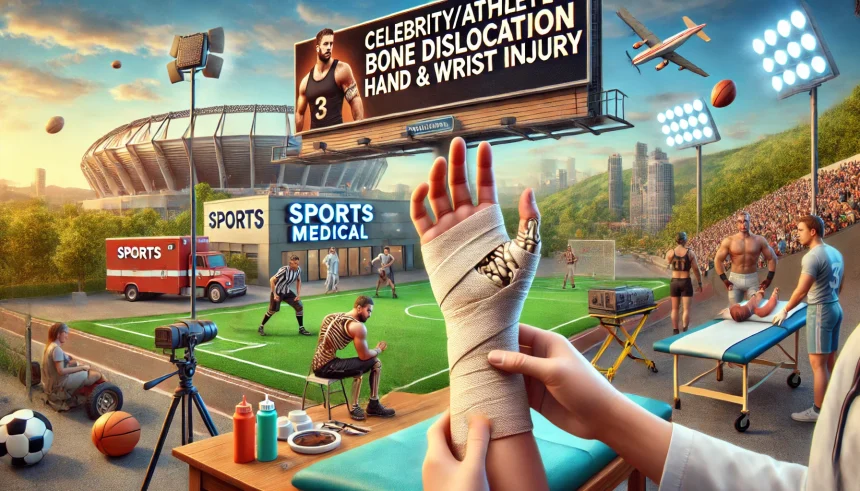In the world of sports and entertainment, injuries are a common challenge. Among them, celebrity/athlete bone dislocation hand and wrist injury is one of the most frequent issues. These injuries often occur due to high-impact activities, accidents, or overuse.
Athletes depend heavily on their hands and wrists for performance, whether gripping, throwing, or hitting. Celebrities, especially those involved in action films, stunts, or musical performances, also face risks. A severe injury can put their careers on hold, requiring urgent medical attention and proper rehabilitation.
Dislocations happen when a bone is forced out of its normal position at a joint. This can occur in fingers, wrists, or even the base of the hand. The pain is intense, and movement becomes difficult or impossible. Without proper treatment, long-term complications like arthritis or reduced mobility can occur.
Medical advancements have helped in treating these injuries effectively. Immediate first aid, professional diagnosis, and rehabilitation play a crucial role in recovery. Many athletes and celebrities have overcome such injuries through proper care, therapy, and persistence.
Preventive measures like wrist guards, proper training, and strengthening exercises can help reduce the chances of these injuries. However, despite precautions, accidents still happen, affecting even the most experienced professionals.
Understanding Bone Dislocation in the Hand and Wrist
A bone dislocation happens when a bone is pushed out of its joint due to sudden impact or force. This injury commonly affects fingers and wrists in high-contact sports and action-based professions. The severity of dislocation varies, depending on how far the bone moves out of place.
There are different types of dislocations in the hand and wrist. Finger dislocations occur at the joints, commonly in basketball, football, and martial arts. Wrist dislocations, such as lunate or perilunate dislocations, are more severe and often require surgery.
Some common causes of these injuries include:
- High-impact sports: Boxing, basketball, football, and gymnastics put extreme stress on the hands and wrists.
- Falls and accidents: Hard landings or sudden impacts can force bones out of position.
- Repetitive motion injuries: Constant stress from gripping or throwing can weaken joints, leading to dislocations.
- Heavy training and competition: Excessive strain on joints increases the risk of injury, especially without proper conditioning.
A dislocated hand or wrist results in intense pain, swelling, and deformity. In severe cases, the bone may break through the skin or damage nearby nerves. Immediate treatment is necessary to prevent further damage and long-term complications.
While many athletes and celebrities recover fully, some experience recurring dislocations or weakness in the affected area. Proper rehabilitation and protective gear are essential to avoid re-injury and regain full functionality.
Notable Celebrity and Athlete Cases
Many well-known figures have suffered celebrity/athlete bone dislocation hand and wrist injury, impacting their careers. Some had to undergo surgery, while others recovered through therapy and rest.
One example is Dillian Whyte, a professional boxer who suffered a gruesome finger injury during training. His finger was severely cut, exposing the bone, which led to the cancellation of his scheduled fight. Boxing, being a high-impact sport, makes hand injuries very common.
Michael Smith, a darts world champion, faced a different kind of injury. He dislocated his wrist and shoulder in a scooter accident. His recovery took weeks, affecting his ability to play and train. Even in non-contact sports, accidents can lead to serious injuries.
In basketball, Angel Reese suffered a small wrist fracture, which she initially played through. However, further scans revealed the risk of long-term complications, leading her to opt for surgery. Early diagnosis is crucial in preventing permanent damage.
Baseball players are also prone to such injuries. Troy Tulowitzki, an MLB shortstop, fractured his wrist after being hit by a pitch. Wrist injuries in baseball can significantly affect a player’s performance, especially in throwing and batting.
These cases highlight how dislocations can happen in various ways. Proper diagnosis, immediate medical attention, and rehabilitation are essential for recovery. Some injuries take weeks, while others require months before full strength is regained.
Symptoms and Diagnosis
The symptoms of a celebrity/athlete bone dislocation hand and wrist injury are immediate and severe. Pain is usually intense, and movement becomes restricted. Swelling and bruising appear quickly, making it difficult to grip or move the fingers.
A clear sign of dislocation is joint deformity. The affected area may look bent or misaligned. In severe cases, the bone may visibly protrude under the skin or even break through. This requires urgent medical attention to realign the joint safely.
Some key symptoms include:
- Severe pain that worsens with movement.
- Swelling and discoloration around the injured joint.
- Numbness or tingling if nerves are affected.
- Loss of mobility, making it difficult to use the hand.
To diagnose the injury, doctors use physical exams and imaging tests. X-rays help identify bone displacement, while MRI scans detect ligament or tendon damage. Early diagnosis ensures proper treatment and reduces the risk of long-term issues.
Ignoring a dislocation or delaying treatment can lead to complications. The joint may become unstable, increasing the risk of future dislocations. Long-term problems like arthritis or chronic pain can also develop, affecting career longevity.
Treatment and Recovery
The treatment for a celebrity/athlete bone dislocation hand and wrist injury depends on the severity of the dislocation. Immediate first aid is essential to prevent further damage. Keeping the joint immobilized and applying ice can help reduce swelling.
Doctors typically perform manual reduction, where they realign the dislocated bone into place. This is followed by splinting or casting to keep the joint stable during healing. Physical therapy is recommended to restore movement and strength.
In cases of severe dislocations, surgery may be required. This is necessary when:
- The bone cannot be manually repositioned.
- There are fractures or ligament tears.
- The dislocation is recurrent and causes instability.
Rehabilitation focuses on regaining flexibility and strength. Gradual exercises help rebuild grip strength, while therapy prevents stiffness. Recovery time varies from weeks to months, depending on the injury’s severity and treatment approach.
Athletes and celebrities often work with specialized therapists to speed up recovery. However, even after healing, the affected joint may remain vulnerable, requiring extra care during physical activity.
Prevention and Long-Term Care
Preventing celebrity/athlete bone dislocation hand and wrist injury is possible with proper training and protective measures. Strengthening the hands and wrists through exercise reduces the risk of injury.
Wearing protective gear such as wrist braces or gloves can provide extra support. Athletes in sports like boxing and gymnastics use wrist wraps to stabilize joints and prevent excessive strain.
Some key prevention strategies include:
- Hand and wrist strengthening exercises to improve stability.
- Proper technique training to avoid unnecessary stress on joints.
- Using protective gear during high-impact activities.
- Regular medical check-ups to monitor joint health and detect early issues.
For those who have suffered past injuries, rehabilitation must continue even after recovery. Stretching, mobility drills, and proper warm-ups help maintain flexibility and reduce the chance of re-injury.
Injuries are a part of professional sports and entertainment, but with the right approach, recovery is possible. Taking preventive measures can help ensure a long, successful career without repeated setbacks.
Conclusion
A celebrity/athlete bone dislocation hand and wrist injury can be a major setback, affecting performance, career longevity, and overall hand functionality. Whether caused by high-impact sports, accidents, or repetitive stress, these injuries require immediate medical attention and proper rehabilitation for a full recovery.
Treatment methods vary based on severity, ranging from manual realignment and splinting to surgery and extensive physical therapy. Early diagnosis and professional care are essential to prevent complications like arthritis, chronic pain, or joint instability, which can impact long-term performance.
Preventive measures such as strengthening exercises, proper technique, and protective gear help reduce the risk of dislocations. Athletes and celebrities who take proactive steps to care for their hands and wrists can recover effectively and continue excelling in their careers.
FAQs
What are the main causes of hand and wrist dislocations in athletes and celebrities?
High-impact sports, falls, accidents, and repetitive stress from training or performances are the primary causes of these injuries.
How long does it take to recover from a bone dislocation in the hand or wrist?
Recovery can take a few weeks to several months, depending on the severity and whether surgery is needed.
Can a dislocated hand or wrist cause long-term damage?
Yes, if not treated properly, it can lead to chronic pain, arthritis, or recurrent dislocations affecting performance.
What are the first steps to take after a hand or wrist dislocation?
Immobilize the joint, apply ice to reduce swelling, and seek immediate medical attention to prevent further damage.
Do athletes and celebrities use special treatments for faster recovery?
Yes, they often use physical therapy, advanced rehabilitation techniques, and protective gear to speed up healing.














